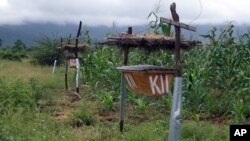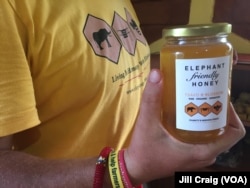It may seem odd that the world's largest land mammal would be afraid of bees, but Kenya-based research and conservation group Save the Elephants has used the elephants' fear of being stung around the eyes, mouth and trunk to deter them from crop-raiding. It is doing this through "beehive fences," which they have found to be 80 percent effective.
"Elephants have come to my farm but they couldn't manage to enter the farm," said Hesron Nzumu, a farmer who lives near the Tsavo East National Park in Kenya. "They see the beehive and they are really afraid of the bees. When they see them, they run away."
Research findings by Save the Elephants, the Kenya Wildlife Service, and the Mwakoma community near Tsavo East have been published in the journal Conservation Biology. Researchers used data collected over a three-and-a-half-year period from 10 farms near Tsavo East where 131 beehives were placed.
They found that only 20 percent of the 253 elephants that entered Mwakoma farms during that time managed to break the fences.
Strong fencing wire outlined the boundary of each trial plot of 0.4 hectares, upon which dummy hives and real hives were alternately suspended every 10 meters. If an elephant disturbed the wire, it would also anger the bees, making the fence essentially "moveable," unlike other stationary deterrents.
"It's a sustainable, long-term, low-cost solution for these small-scale farms, and we're not at all pretending this is going to work on a large-scale, for 100-acre farms; this is for the one-acre, two-acres farms, who have absolutely minimal income," said Lucy King, who heads the Human-Elephant Coexistence Program at Save the Elephants, and is the lead author of the paper.
Honey provided by the bees gives farmers added income, says King, who offers an example of a farmer in her study who makes $22 per month. With earnings from honey, he and his colleagues could each make as much as an extra $100 to $200 a year — a significant increase.
Nzumu is one of the farmers who has benefited from the honey.
"The beehive protects my farm from elephants," he said. "Secondly, I harvest the honey and sell it and sometimes we use it at home. Most of the honey we sell so that we can reduce poverty and also pay school fees for our children." Nzumu added that the bees also help with pollination of his crops.
When it comes to poaching, sedentary farmers rarely become poachers, says King, but she adds that it is not uncommon to hear of farming communities that turn a blind eye when poachers come into the area because they are angry at the elephants.
Like many other conservationists, King argues that in the long term, human-wildlife conflict will be a bigger threat to elephants than poaching.
"And it's just going to be such a conflict because they require so much food and they need to move across the landscape. If they don't, they start to damage vegetation in a very quick manner. And so these elephants have to be allowed large areas of land. And it's becoming less viable in Africa, which is developing so fast and the human population is expanding so fast," King said.
King says that farmers have promoted the fences to their neighbors, resulting in 24 farms in the area now using them. And it looks like the buzz is spreading: Beehive fences are being tested in 14 countries across Africa and Asia.









